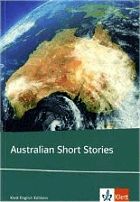
 The Drover's Wife by Henry Lawson (hier online bestellen)
The Drover's Wife by Henry Lawson (hier online bestellen)
The story:
1. Prelude – a bushwoman with her 4 children and a dog living in a wooden house while her husband is away.
2. Appearance of the snake.
3. Disappearance of the snake into the cracks in the floor.
4. Thunderstorm and darkness appears, and she takes the children inside. She stayed up the night to wait for the snake to reappear.
5. Reappearance of the snake as dawn approaches.
6. The dog captures the snake.
7. The bushwoman kills the snake.
What is a drover?
- a person who drives cattle or sheep
- moves cattle into new lands and out of markets
- walk the vast herds across, or up and down the continent
- maybe months on the road
- mode of transportation: motorbikes and horses
Note: Droving is carried out along well-established stock routes on which camps, watering places and grass for grazing are available. Cattle are often driven for over 3000km.
Excerpt from book:
The two-roomed house is built of round timber, slabs, and stringy-bark, and floored with split slabs. A big bark kitchen standing at one end is larger than the house itself, veranda included. Bush all round—bush with no horizon, for the country is flat. No ranges in the distance. The bush consists of stunted, rotten native apple-trees. No undergrowth. Nothing to relieve the eye save the darker green of a few she-oaks which are sighing above the narrow, almost waterless creek. Nineteen miles to the nearest sign of civilization—a shanty on the main road.
The drover, an ex-squatter, is away with sheep. His wife and children are left here alone.
Four ragged, dried-up-looking children are playing about the house. Suddenly one of them yells: “Snake! Mother, here’s a snake!”
The gaunt, sun-browned bushwoman dashes from the kitchen, snatches her baby from the ground, holds it on her left hip, and reaches for a stick.
“Where is it?”
“Here! gone into the wood-heap!” yells the eldest boy—a sharp-faced urchin of eleven. “Stop there, mother! I’ll have him. Stand back! I’ll have the beggar.”
“Tommy, come here, or you’ll be bit. Come here at once when I tell you, you little wretch!”
The youngster comes reluctantly, carrying a stick bigger than himself. Then he yells, triumphantly:
“There it goes—under the house!” and darts away with club uplifted. At the same time the big, black, yellow-eyed dog-of-all-breeds, who has shown the wildest interest in the proceedings, breaks his chain and rushes after that snake. He is a moment late, however, and his nose reaches the crack in the slabs just as the end of its tail disappears. Almost at the same moment the boy’s club comes down and skins the aforesaid nose. Alligator takes small notice of this, and proceeds to undermine the building; but he is subdued after a struggle and chained up. They cannot afford to lose him.
The drover’s wife makes the children stand together near the dog-house while she watches for the snake. She gets two small dishes of milk and sets them down near the wall to tempt it to come out; but an hour goes by and it does not show itself.
It is near sunset, and a thunderstorm is coming. The children must be brought inside. She will not take them into the house, for she knows the snake is there, and may at any moment come up through a crack in the rough slab floor; so she carries several armfuls of firewood into the kitchen, and then takes the children there. The kitchen has no floor—or, rather, an earthen one—called a “ground floor” in this part of the bush. There is a large, roughly-made table in the centre of the place. She brings the children in, and makes them get on this table. They are two boys and two girls—mere babies. She gives them some supper, and then, before it gets dark, she goes into the house, and snatches up some pillows and bedclothes—expecting to see or lay her hand on the snake any minute. She makes a bed on the kitchen table for the children, and sits down beside it to watch all night.
About the author:
Henry Lawson was born in New South Wales, in 1867. His father was a Norwegian sailor, named Niels Larsen, but he later changed his name to Peter Lawson. Henry Lawson grew up in poor surroundings, and had several problems. He suffered of deafness, and was in prison several times because he didn't pay his child support for his two children and he also had problems with alcoholism. He has been described as one of the greatest writers in Australian history. He also had a great believe in a new workingman "revolution" in Australia.
Buchdaten:
Taschenbuch: 160 Seiten
Verlag: Klett (Oktober 2010)
Sprache: Englisch
ISBN-10: 3125791227
ISBN-13: 978-3125791220
ISBN: 3125791227
Preis: € 7,99
|  The Drover's Wife by Henry Lawson (hier online bestellen)
The Drover's Wife by Henry Lawson (hier online bestellen)